While three-quarters of investors worry about market volatility, smart companies use predictive analytics in real estate to turn uncertainty into advantage. Here, you will learn how to identify opportunities before competitors and reduce investment risks.
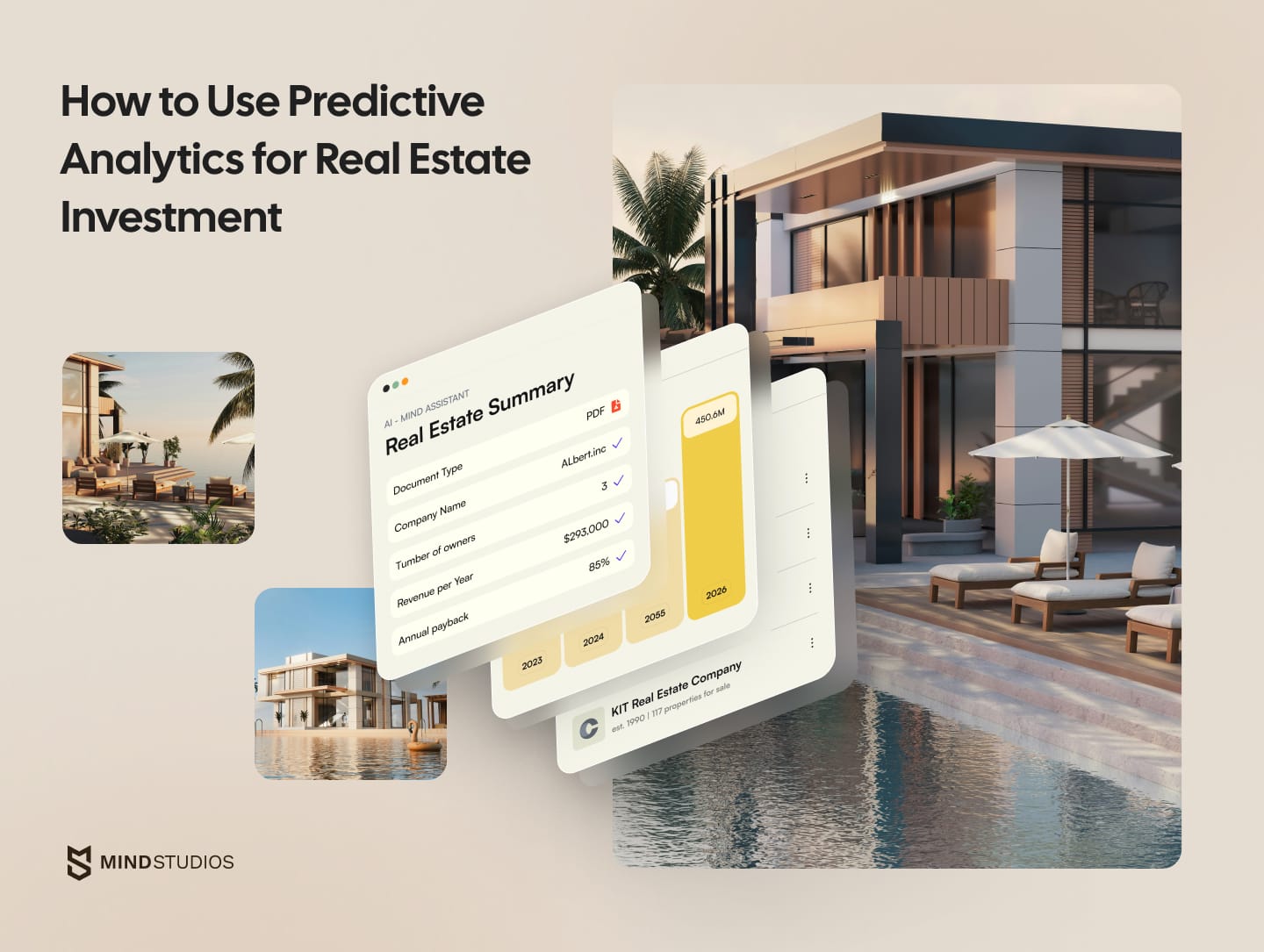
Highlights:
- Market volatility makes traditional real estate analysis obsolete.
- From our experience, predictive analytics delivers 15–25% better investment accuracy than conventional methods.
- Companies using data-driven decisions move 3x faster than competitors.
If you're in real estate investment today, you definitely know how challenging the market has become.
Today's market conditions create unprecedented uncertainty:
- 82% of homeowners with mortgages had interest rates below 6% as of Q4 2024;
- While 44% of investment firms surveyed report changing their investment plans to adapt to market volatility.
Traditional real estate analysis (that is usually built on historical ROI calculations, comparable sales, as well as cap rates) falls short in this volatile environment. This happens simply because backward-looking methods can't predict sudden market shifts or identify emerging opportunities before they become obvious to competitors.
Harnessing predictive analytics in real estate provides the solution. This technology uses machine learning and real-time data to help investors forecast demand, assess risks, and make confident data-driven investment decisions despite market uncertainty.
Drawing from Mind Studios' decade of experience building custom predictive analytics platforms for real estate clients, we understand the unique challenges companies face when implementing data-driven solutions.
Ready to explore what's possible with your data? Contact our team to discuss your predictive analytics requirements.
Does predictive analytics work for real estate?
The answer is yes, and here's how.
The real estate market presents unique challenges that traditional analysis methods simply can't handle.
Interest rates spiked during the spring home-buying season to hit all-new highs, putting homebuyers back on the sidelines, while internet of things in commercial real estate continues to reshape how investors manage assets and optimize performance even amid a 15-year high in interest rates.
This economic volatility in real estate creates three critical challenges for traditional analysis:
- Unpredictable pricing. A survey by the National Association of Home Builders showed 37% of builders cutting prices by an average of 5% (!) — the highest level since monthly tracking began in 2022. When pricing changes this rapidly, historical comparables become unreliable.
- Interest rate volatility. Mortgage rates continue to fluctuate dramatically, making long-term planning difficult and rendering traditional cap rate calculations obsolete within months.
- Inconsistent demand. The "lock-in effect" keeps inventory artificially low while buyer behavior remains unpredictable, breaking traditional demand forecasting models.
Why does the traditional model fail?
Traditional models that only look at past sales and cap rates don't work well in today's market because they expect stability that simply isn't there. These old methods are reactive, meaning by the time you see the changes, it's already too late, and competitors have moved first.
Instead, you need forward-looking real estate analytics and the ability to make quick decisions when market conditions change every month rather than every year. In this regard, predictive analytics in the real estate industry transforms how companies approach investment decisions by providing actionable insights before market changes become apparent to competitors.
How can data extraction improve real estate?
Top real estate companies already use predictive analytics in real estate to maintain competitive advantages during volatile periods. These forward-looking strategies help them remain profitable while others struggle with uncertainty.
Leading firms leverage predictive analytics in the real estate industry to:
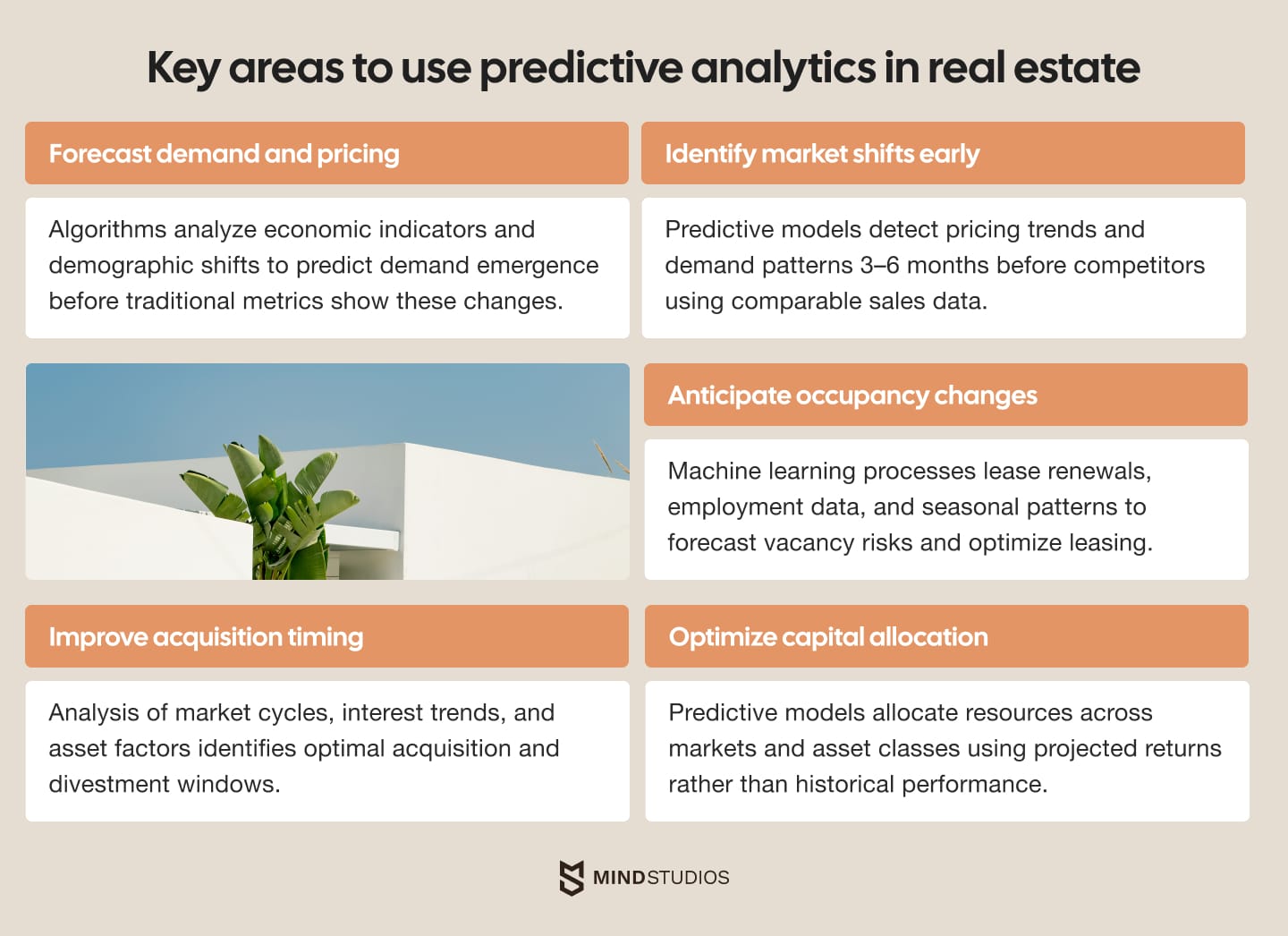
How is data analytics being used in real estate?
Modern real estate companies are adopting predictive analytics across many areas of their operations. Here are the core applications of predictive analytics in real estate:
Property valuation and pricing optimization
Algorithms process millions of data points, including sales history, market trends, demographic shifts, and economic indicators, to provide accurate property value forecasting. Companies like Quantarium use neural networks and machine learning to assess over 150 million properties with 900+ data points each.
Investment risk assessment and portfolio management
Predictive models analyze market volatility, tenant quality, location factors, and economic conditions to provide automated risk scoring. This enables investors to evaluate hundreds of properties simultaneously and compare risk profiles objectively through comprehensive portfolio performance tracking.
Market timing and opportunity identification
Real-time demand analysis processes employment data, population shifts, infrastructure development, and consumer behavior to identify emerging market hotspots 6–12 months before they become obvious to competitors.
Tenant screening and occupancy forecasting
AI in real estate analyzes credit scores, employment history, rental patterns, and behavioral data to predict tenant reliability. Advanced systems can predict occupancy rates and optimize rental pricing forecasts based on local market conditions using sophisticated real estate investment KPIs.
Mind Studios’ insight: The most effective tenant analytics combine traditional credit data with alternative data sources like utility payment history and previous lease compliance. This approach reduces tenant default rates by up to 40% compared to credit-score-only screening.
Lead generation and client targeting
Platforms (like SmartZip, for example) analyze social media data, search behavior, and purchase patterns to identify homeowners likely to sell within 12–18 months. This enables targeted marketing with 72% prediction accuracy rates.
Market trend analysis and forecasting
Analytics platforms process economic indicators, demographic changes, as well as regional development plans to provide market trend prediction that guides long-term strategy decisions. These systems incorporate historical trend modeling and location-based risk insights to deliver comprehensive market intelligence.
What it takes to become a predictive-driven real estate company
Converting from traditional analysis methods to predictive-driven operations requires fundamental changes in how your organization collects data, makes decisions, and measures success.
Today, many companies assume they're ready for predictive analytics without honestly evaluating their current capabilities.
Don't let another opportunity slip away while you're still relying on outdated analysis methods. Download the complete 15-minute assessment to discover if your company is ready for predictive analytics transformation.
How can real estate firms avoid predictive analytics pitfalls and implement it the right way?
Many real estate business owners hesitate to adopt predictive analytics for modern real estate investments. This happens not because of a lack of interest, but due to persistent misconceptions about implementation and results.
By knowing common pitfalls, you can avoid costly mistakes and achieve meaningful results faster.
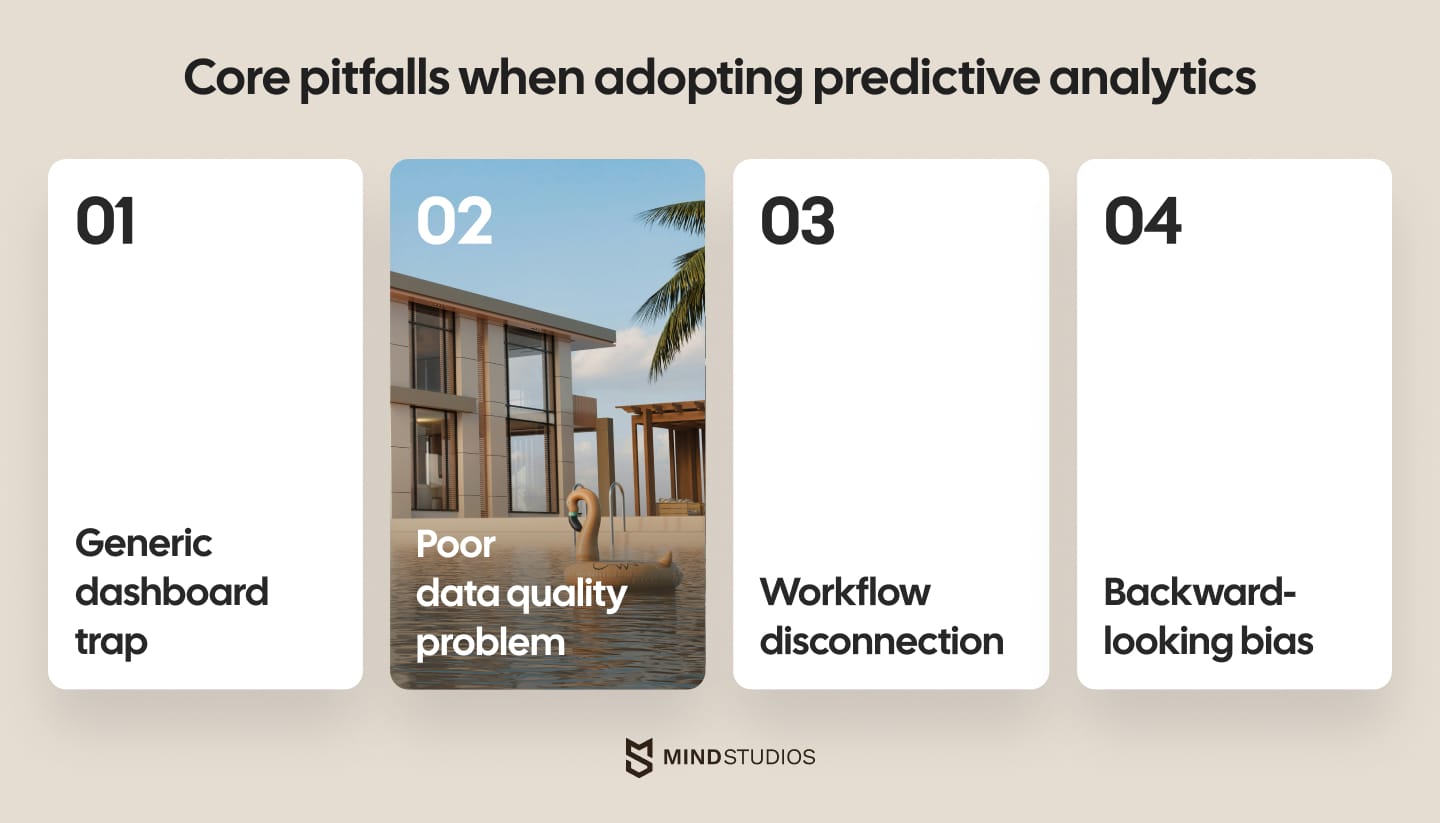
#1 Using generic BI dashboards without real estate logic
Standard business intelligence tools lack the specialized algorithms and data models required for accurate real estate predictions. Generic dashboards show what happened, but can't predict what will happen next.
Mind Studios’ insight: We've seen firms waste 6–12 months trying to force generic analytics tools to work for real estate. But the fundamental issue is that real estate data has unique characteristics (such as seasonal patterns, location dependencies, and regulatory factors) that require specialized modeling approaches. And off-the-shelf BI tools simply weren't designed for property value forecasting or occupancy prediction.
#2 Poor data quality and fragmentation
Poor data quality is one of the biggest roadblocks in predictive analytics, as fragmented, incomplete, or scattered real estate data makes it difficult to extract meaningful insights. What’s more, without reliable data foundations, even sophisticated models produce inaccurate predictions.
#3 No integration into investment workflows
Many real estate companies build impressive analytics capabilities but fail to integrate insights into actual decision-making processes. When predictions don't influence real investment choices, the technology provides no business value.
#4 Obsession with historical ROI instead of forward indicators
Traditional metrics (such as historical returns and cap rates) do matter. But focusing exclusively on backward-looking indicators limits predictive accuracy in volatile markets.
Mind Studios’ recommendation: Companies achieving the best results balance historical performance data with leading indicators like market sentiment, demographic shifts, and economic trends.
We recommend implementing metrics that predict future cash flows, occupancy rates, and market appreciation rather than just reporting what happened last quarter. This shift in measurement philosophy is often more challenging than the technical implementation.
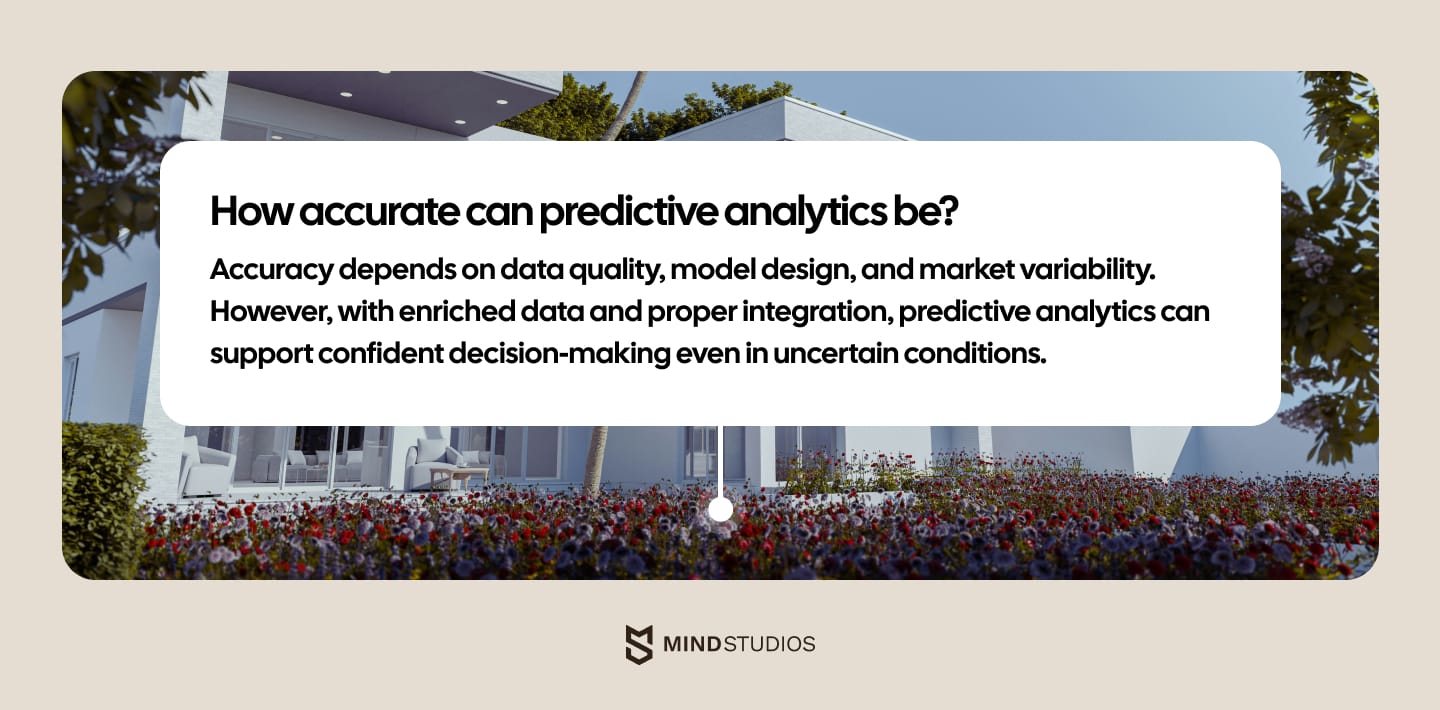
Successful implementation framework for predictive analytics in real estate
Understanding the pitfalls is only half the battle. The real challenge lies in adopting predictive analytics correctly from day one.
Through the years, we saw too many real estate companies jumping into analytics projects without proper planning. This only led to expensive failures and lost confidence in data-driven approaches.
The truth is, building predictive analytics in real estate that delivers measurable business results requires more than just good intentions and budget allocation.
Here's our proven framework for successful predictive analytics deployment:

Choose your technology approach strategically
The first critical decision you should make is selecting between off-the-shelf and custom solutions. But what’s the difference?
- Off-the-shelf platforms work well for basic analytics needs and provide faster time-to-market. This makes them suitable for companies wanting to test predictive analytics capabilities quickly.
- In contrast, a custom analytics dashboard provides sustainable competitive advantages through specialized algorithms and proprietary data integration. They are also very difficult for competitors to replicate.
Establish your data foundation
Predictive analytics success depends entirely on data quality and completeness. Thus, before building any models, you should audit your current data sources and identify gaps that need addressing.
Your data readiness checklist should include:
- Financial performance data: NOI, cash flows, and debt service for accurate ROI calculations;
- CRM and tenant data: lease terms, renewal rates, and tenant profiles for occupancy forecasting;
- Leasing history: occupancy trends, rental rates, and concessions for market pattern analysis;
- Location intelligence: demographics, employment, and development plans for demand forecasting;
- External market data: interest rates, economic indicators, and competitor activity for comprehensive risk assessment.
Plan for seamless integration
Even the most sophisticated predictive analytics platform becomes worthless if your team doesn't adopt and use it.
You should ensure analytics tools integrate seamlessly with existing workflows and systems your team already relies on. Plus, plan connections to Excel models, internal dashboards, CRM systems, and portfolio management platforms from the beginning.
This integration planning maximizes adoption rates and ensures insights actually influence investment decisions.
Structure your team and budget appropriately
Successful implementation doesn't require building an AI lab from scratch or hiring a team of data scientists. But it does require a dedicated product owner who understands both real estate operations and technology requirements, as well as bridges the gap between technical capabilities and business needs.
Plus, you should also budget comprehensively for data preparation, model development, and ongoing refinement, not just initial platform costs.
AnyCurb: a predictive analytics success story
Most real estate professionals waste countless hours chasing leads that never convert, while the best opportunities slip away to competitors who spot them first.
The AnyCurb platform demonstrates exactly how predictive analytics function in real estate to solve this fundamental problem: by identifying which properties are likely to sell before they hit the market.

Typically, traditional real estate operates on reactive principles: agents wait for listings to appear, then compete with dozens of others for the same opportunities.
This approach creates several critical challenges:
| Limited market visibility | Prediction guesswork | Competitive disadvantage |
|---|---|---|
| Surely, off-market properties represent significant opportunities. But manually identifying potential sellers is time-intensive and unreliable. | Without data-driven insights, agents can't accurately predict which properties will actually sell, leading to wasted effort on dead-end leads. | By the time properties appear on traditional platforms, the advantage goes to whoever responds fastest, rather than to whoever identified the opportunity earliest. |
Mind Studios developed AnyCurb as a comprehensive real estate marketplace that uses advanced predictive modeling to solve these discovery challenges:
- Intelligent property scoring. The platform's proprietary algorithm analyzes over 300 data points, including owner behavior patterns, property characteristics, local market conditions, and economic indicators to assign each home a likely-to-sell score with 85% accuracy (verified by third-party testing).
- Automated off-market discovery. Rather than manually surveying property owners, the system continuously processes data from multiple sources to automatically identify potential sellers and hidden opportunities before they become public knowledge.
- Seamless data integration. The platform combines MLS data with proprietary off-market intelligence through advanced asset-level analytics, giving users access to both traditional listings and exclusive opportunities via an integrated risk assessment dashboard.
This case study illustrates how predictive analytics is transforming real estate investment strategies from reactive searching to proactive opportunity identification.
The key insight: success comes not from having more data, but from having data that predicts what happens next.
Inspired by AnyCurb's success? Let's talk about how predictive analytics could support your investment strategy.
Wrapping up
Success in real estate no longer depends on who has the most historical data, but on who can make the fastest, most accurate predictions about future market conditions.
With 76% of investors concerned about market volatility and traditional analysis methods failing to handle current uncertainty, predictive analytics in real estate has become a competitive necessity, not a nice-to-have. Firms that use advanced analytics make faster, more confident decisions, while competitors struggle with uncertainty.
You can't afford to "wait and see" — by the time market changes appear in traditional metrics, data-driven operators have already captured the best opportunities. Mind Studios creates custom decision engines that integrate seamlessly into investment workflows, focusing on using real estate predictive analytics for practical business outcomes rather than impressive visualizations.
Want to stay ahead in real estate? Let's explore how predictive analytics can boost your competitive advantage and transform your investment strategy for long-term success.


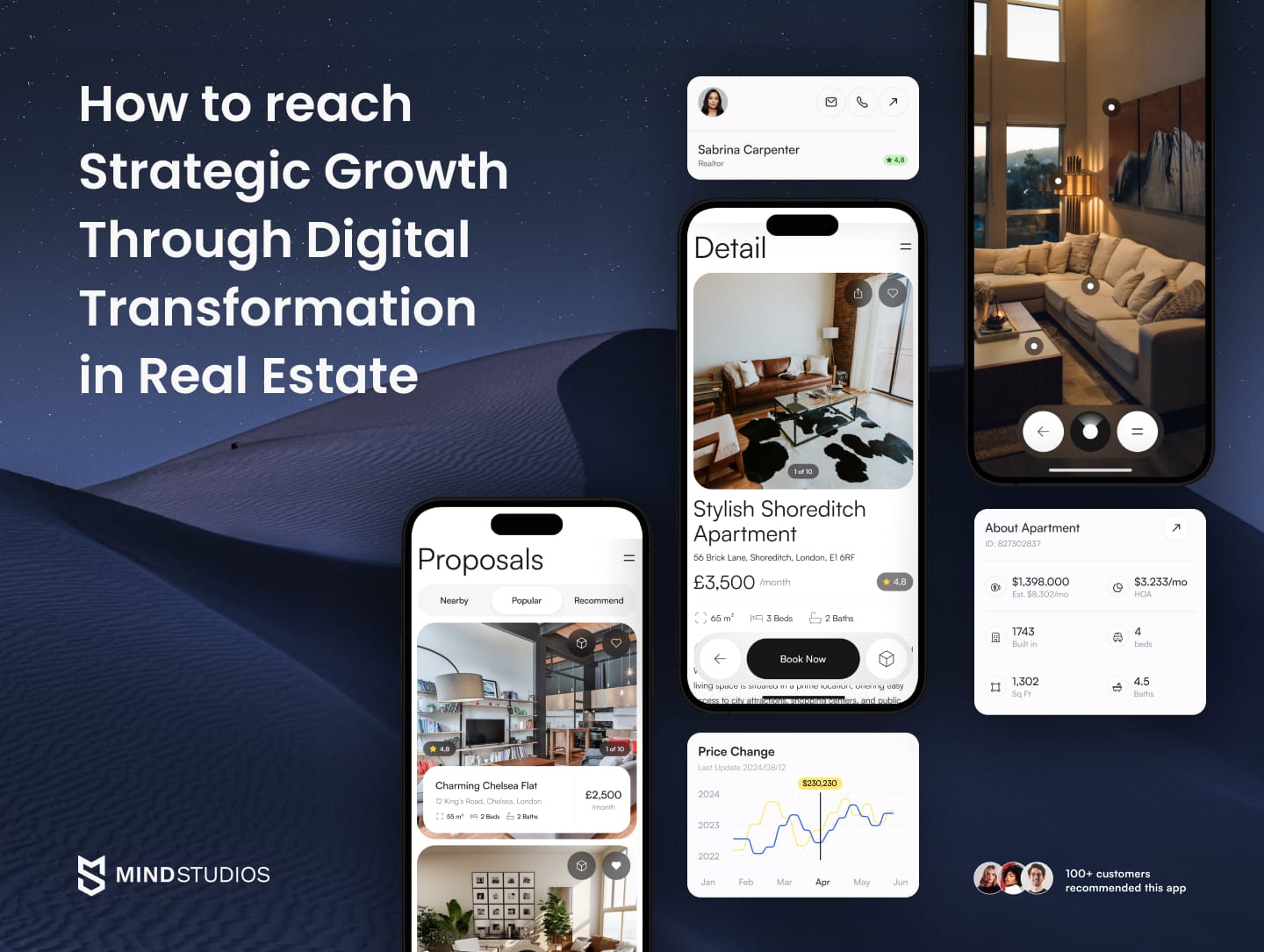
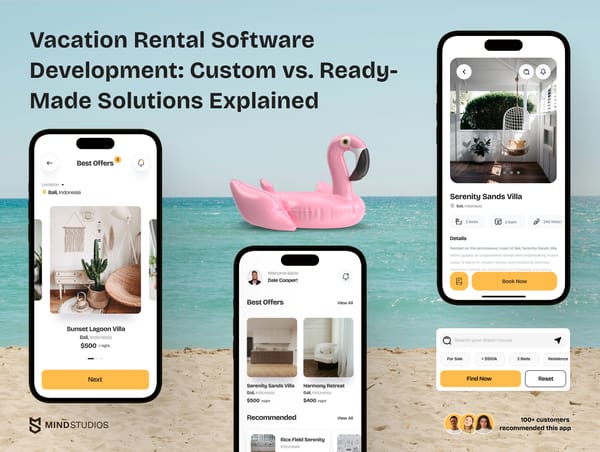
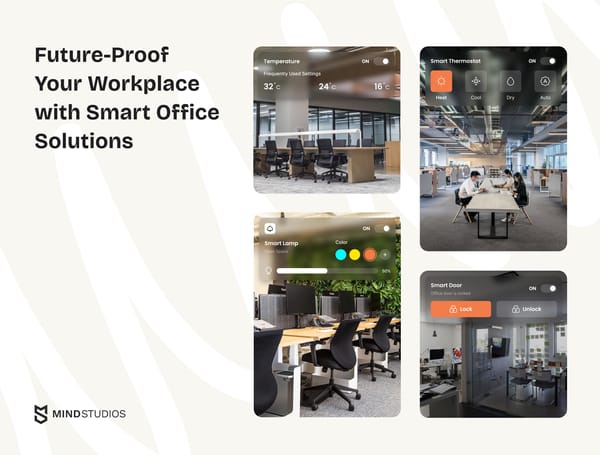


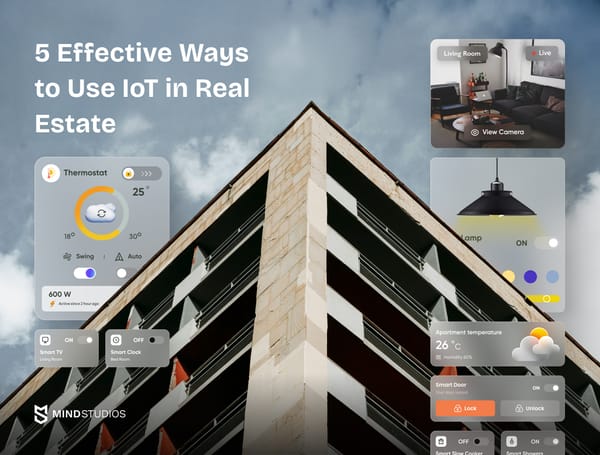
![How to Create an On-Demand Medicine Delivery App [Expert Guide]](https://themindstudios.com/blog/content/images/size/w600/2025/03/IMG-1-Cover-6.jpg)

